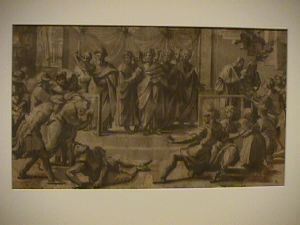Artist: Ugo da Carpi (Italian, ca. 1480-after 1525)
Medium: woodcut on paper
Dimensions: 10 1/2 in. x 16 1/4 in. (26.7 cm. x 41.3 cm.)
Credit Line: Bequest of the Honorable James Bowdoin III
Accession Number: 1811.72
The traditional attribution of this sheet to Nicholas Poussin was questioned as early as 1914 by Frank Jewett Mather, who ascribed it generally to Rome during the first half of the seventeenth century. Other scholars have most often connected it with Maratti or his school.1 Recently, Manuela Mena Marqués has affirmed its attribution to Maratti himself.2 Its subject matter relates to that of Maratti's decorations for the Presentation Chapel dedicated to the Virgin Mary in St. Peter's, Rome. These occupied him for over forty years and remained unfinished at his death. Maratti was responsible for the dome, six half-lunettes, and intervening pendentives. The subjects included both Old Testament prophets and three heroine prefigurations of the Virgin: Miriam, Jael, and Judith. The latter two subjects together formed a lunette above the altar, each flanking a window; they were executed in mosaic after Maratti's painted cartoons. The dome painting of the Virgin Immaculate was finished after Maratti's death by his pupil Giuseppe Chiari.3
Maratti developed his design for the half-lunette Jael and Sisera through an extensive series of drawings, at least twenty-five of which have been identified.4 The final design, which was executed, depicts the triumphant Jael standing over the slain Sisera, pointing out his body to her countrymen. However, the earliest sketches known, a group in Würzburg and Madrid, show an earlier moment in the drama, as Jael raises the hammer to drive the nail into the head of the sleeping Sisera.5
It is this earlier and more dramatic moment which is shown in the Bowdoin sketch, which does not conform to the eventually established format of the half-lunette. Therefore, it could be among Maratti's preliminary thoughts about his subject, or it could be a later variation on it. He is known to have painted later versions of many of his compositions and was commissioned to do so for these subjects as well.6 Mena Marqués has indicated a drawing in the Biblioteca Nacional, Madrid, which is related to the Bowdoin depiction of this subject. It also shows the act of murder and likewise does not conform to the St. Peter's composition.7 The verso of the Bowdoin drawing contains finished sketches of Judith's hands, for the pendant subject of Judith and Holofernes. Jean and Robert Westin theorize that Maratti's designs for the Jael and Judith subjects are among the earliest he worked on for the St. Peter's commission, in the early 1670s.8
1 . Unsigned note on the mount of the Witt Library photograph, "close to Maratti"; Jacob Bean associated it with the Maratti circle, in conversation with the author, 1980; and Oberhuber and Montagu both tentatively suggested an attribution to Maratti himself (comments in BCMA files).
2. Letter to the author, 29 December 1983.
3. See Macandrew 1980, p. 129, for a concise synopsis of the project.
4. F. H. Dowley, review of Nieto Alcaide 1965 in Art Bulletin, vol. 52, no. 4 (December 1970), pp. 458-59. In addition, a sheet in the Clark Bequest at the Philadelphia Museum of Art has been associated with this commission (Philadelphia 1980-1981, cat. no. I., repr.).
5. The Würzburg sheet is repr. in Master Drawings, vol. 3, no. 2 (1965), pl. 37a; the Madrid sheet is repr. in Nieto Alcaide 1965, no. 41 , pl. 26. In addition, a detail study in the Metropolitan Museum shows Jael's hand upraised with the hammer (repr. Bean 1979, cat. no. 275).
6. Macandrew 1980, p. 129.
7. Inv. Barcia 8241; the sheet is not by Maratti himself, according to Mena Marqués.
8. Museum of Art, Pennsylvania State University, Carlo Maratti and His Contemporaries (exh. cat. by J. K. Westin and R. H. Westin), 1975, p. 65.
Commentary credited to David P. Becker (or not otherwise captioned) appeared in his catalogue Old Master Drawings at Bowdoin College (Brunswick: Bowdoin College Museum of Art, 1985).


 Museum of Art
Museum of Art